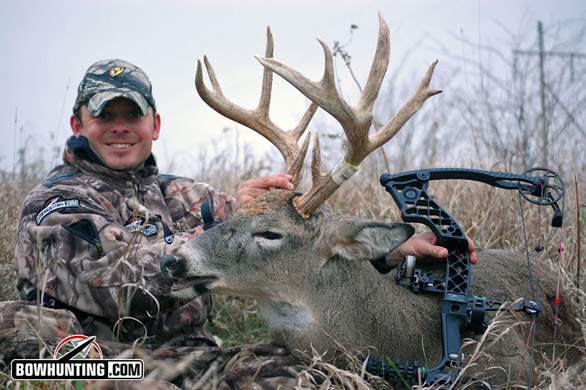LAST UPDATED: May 1st, 2015
Every spring and summer the questions are the same. “Why were you late for my brother’s graduation party?” “Why are you so tired at work today?” “Why is the grass in your yard two feet tall?” “Why did you buy my Mother’s Day present at Menards?” The answer to all of the above is………SOYBEANS.
When Steve Flores, Senior Editor at bowhunting.com, asked if I would like to write a series of articles for our readers I said “Sure, why not”. If there is one topic that I feel comfortable writing about its food plots. In fact, I can talk food plot design and strategy all day. I was given four specific deadlines for the articles. Of course, as I am writing this, my deadline has already passed. Why am I late? SOYBEANS!
From the time I start to plant food plots in the spring until I quit hunting in the fall, soybeans are the center of my food plot plan. It has been a wet spring here in the Midwest, so when it finally dried up two weeks ago Frank (my hunting partner) and I started to work on plots; which unfortunately put this article on the backburner (just for a while). I couldn’t help it. After all, the one thing that’s going to help us be successful in the fall is SOYBEANS.
If you plant it they will come. The author and his hunting partner have a proven method for bringing bucks within bow –range.
First Things First
Throughout my series of articles I’m going to cover everything you need to know about soybeans; from planting to spraying, and finally, hunting strategies. So, let’s start with the reasons that I love beans.
1. They are very easy to grow.
2. They are inexpensive.
3. They can be planted clear until July.
4. They provide great nutrition during the summer and late winter.
Soybeans have a host of advantages over other food-plot options; many of which bowhunters will find easy on the wallet….that is until the taxidermy bill arrives.
Planting Methods
I think a lot of people overlook the ease of which beans grow. In fact, you can drop a soybean on a gravel road and if it gets wet….it will grow. There are three methods for planting beans; planting, drilling, or broadcasting. Planting beans is my preferred method. I use a John Deere 7000 series four row. This is the easiest method for getting a good stand of beans but it is also the most expensive.
There are several methods for getting your beans in the ground. Choose the one that best suits your needs and your means. After all, it really doesn’t matter how you plant your soybeans…..as long as you plant them.
The second method is drilling. We use a grain drill to put our beans in where we have very high deer populations. The deer do not seem to eat drilled beans during the early stages of growth nearly as bad as when beans are “planted”. When you drill beans the rows are 7 inches apart as compared to 15 – 38 inches when planted. The deer prefer to walk down the wide rows and eat the beans. The downside to using a drill is when you work the ground when it is wet and everything becomes a cloddy mess. A drill usually doesn’t have enough down pressure to bust up the clods, and this prevents you from getting good “seed to soil contact” with leads to a diminished stand of beans.
Broadcasting beans is often an overlooked, but very effective, method. I have used everything from my hand spreader to a fertilizer spreader on my ATV. When you decide to broadcast your beans, you need the soil to be worked up very well. It needs to be fluffy and resemble your garden soil after tilling. Once you have the soil ready, the next step is waiting for a rain. Immediate rainfall is the key. I like to wait until the day before a good rain and then broadcast my beans. Broadcast your beans at 200,000 beans per acre. The bag that your beans come in will have the number of seeds per bag so you can gauge how much you are planting. There are usually around 140,000 beans in a bag. Once you have them on the ground, you can roll the beans in with a lawn roller. This will allow the seed to have a little seed to soil contact. This method can be surprisingly effective.
Nothing beats the attraction of a well-placed, well-planted food plot. Deer simply can’t resist.
The cost of planting soybeans for your food plots versus corn is another reason I love soybeans. Soybeans are relatively inexpensive and can usually be found for $40-$50 dollars per bag. One bag of beans will plant 3/4 of an acre to a full acre depending on the population at which you plant. In addition, planting beans also has a wide range of planting dates. It’s recommended that the ground temperature be close to 60 degrees before you plant. This can happen as early as April 1st in central Illinois. One thing to remember though is that the earlier you plant the beans, the more susceptible to disease they become. The reason soybeans have such a long window of planting time is because they mature and die by the daylight hours. Soybeans can be planted as late as July, and as long as they get moisture, they will grow.
To Be Continued
As I stated earlier beans are the hub of my food plot scheme. Deer will start eating beans as soon as they come up and continue eating them until they start to lose their leaves. This will occur on a normal year in late September. From this time until the end of the rut, the deer tend to cut back on eating standing beans. In central IL the deer will start to feed heavily trying to replenish the body weight that was lost during the rut and start hitting your beans again around Thanksgiving. The deer will continue to use the standing beans until they are gone or spring comes.
Now is the time to start thinking about what your food plot plan will include. For the author, the choice is simple…..SOYBEANS.
Frank and I have had tremendous success hunting over our soybean plots. They have produced or aided in our best bow kills to date; both of which we killed last fall. We were blessed to kill those deer but the soybeans that they were feeding on sure helped to tip the odds in our favor. Stay tuned for part 2!

 By
By 




